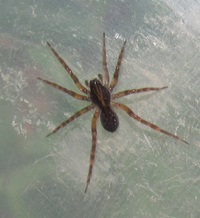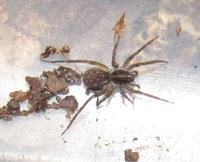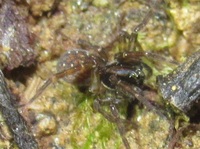Distribution Records
PDF
Vetting Levels |
|
Adult phenology:
High Mountains (HM) ≥ 4,000 ft.
Low Mountains (LM) < 4,000 ft.
Piedmont (Pd)
Coastal Plain (CP)
Click on graph to enlarge
|
 |
|
| synonym | |
| taxonomic_comments |
|
| species_comment |
|
| id_comments |
Description of male .—From the E. S . George Reserve, Livingston Co ., Michigan,
VIII-3-51, H.K .W. 1448 . Carapace 2.07 mm long, 1 .55 mm wide, with a wide marginal
light area and the usual tuning-fork pattern . Dorsum heavily pigmented, with narrow light
colored area over the heart and four pairs of patches of white scales . Coxae and endite s
light, without pigment, sternum and labium lightly pigmented ; venter with irregular
patches of pigment .
Anterior eye row narrower than median row, slightly procurved ; the anterior median
eyes twice as large as laterals, closer to laterals than to each other . Clypeus height equal t o
diameter of anterior lateral eye . Lower margin of furrow of checlicerae armed with thre e
unequal teeth, the middle tooth the largest, the lateral the smallest, the middle tooth
closer to the lateral than to the median .
Legs 4123, banded. Tibia I with seven ventral and lateral spines . Tibia II with eight
ventral and lateral spines. For palpus see Fig . 58 .
Description of female .—Same data as male . Carapace 2 .20 mm long, 1 .58 mm wide ,
with a wide marginal light area and tuning fork pattern ; color and pattern as in the mal e
(Figs. 56-57). Eye arrangement and dentition of chelicerae as in the male . Epigynum (Fig .
60) .
Legs 4123, faintly banded. Tibia I with six ventral and lateral spines. Tibia II with
five ventral and lateral spines. |
| total_length |
Male Carapace 2.07 mm long, 1 .55 mm wide, female Carapace 2 .20 mm long, 1 .58 mm wide. |
| structural_features |
|
| silk_web |
|
| fld_guide_descriptions |
|
| online_photos |
|
| prey |
|
| predators |
|
| behavior |
|
| distribution_reference |
|
| technical_reference |
|
| adult_id | 1 identifiable by photo 2 identifiable by photo of specific features and/or supplementary info 3 identifiable from specimen only |
| abundance |
Summer. Males have been taken from May into August but most from June and July . The earliest record of a female is from April, none in May and three from September . Most of the records are from June, July and August . Females with egg sacs have been taken in June, July and August. |
| distribution_comments |
Northeastern United States and Canada, east of the Dakotas, south to Georgia, North Carolina and Virginia.
Washington, D.C. |
checklist_mt_high
>=4,000 ft. | |
checklist_mt_low
<4,000 ft. | |
checklist_pd
Piedmont | |
checklist_cp
Coastal Plain | |
| habitat |
old field, roadside vegetation, swamps, bogs, ponds and marshes. |
| observation_methods |
|
| state_protection |
|
| NHP_ranks |
|
| NHP_status |
|
| status_comments |
|
Photo Gallery for Pirata aspirans a pirate wolf spider |
 | Recorded by: Brian Bockhahn
Caldwell Co.
Comment: |  | Recorded by: Brian Bockhahn
Graham Co.
Comment: |
 | Recorded by: Brian Bockhahn
Surry Co.
Comment: |